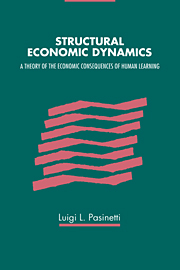Book contents
- Frontmatter
- Contents
- Preface
- Acknowledgements
- List of symbols
- I Economic theory and the neglect of structural change
- II A pure labour production economy
- III Proportional dynamics
- IV Structural dynamics
- V The evolving structure and level of prices
- VI Consumption, savings, rate of interest and inter-temporal distribution of income
- VII On the evolving structure of long-term development
- VIII From the ‘actual’ towards the ‘natural’ economic system – the rôle of institutions
- IX Boundedness of economic systems, and international economic relations
- References
- Index
IV - Structural dynamics
Published online by Cambridge University Press: 17 September 2009
- Frontmatter
- Contents
- Preface
- Acknowledgements
- List of symbols
- I Economic theory and the neglect of structural change
- II A pure labour production economy
- III Proportional dynamics
- IV Structural dynamics
- V The evolving structure and level of prices
- VI Consumption, savings, rate of interest and inter-temporal distribution of income
- VII On the evolving structure of long-term development
- VIII From the ‘actual’ towards the ‘natural’ economic system – the rôle of institutions
- IX Boundedness of economic systems, and international economic relations
- References
- Index
Summary
Introducing technical progress
As soon as we abandon the artificial hypotheses of proportional dynamics and try to move nearer the phenomena that characterize the reality of industrial economic systems, we have no choice but to find a way to introduce into economic analysis, explicitly and without artificial restrictions, that widespread phenomenon of individual and social learning which constitutes the primum movens of industrial societies. Without making too many distinctions, which would carry prejudicial concepts with them, we shall simply label it with the all-embracing term of ‘technical progress’.
Obviously we do not intend to go into an investigation of the deep sources of technical progress; a complex social phenomenon, which cannot but be accepted here as a given external datum. However, to assume technical progress as a datum does not mean assuming technology as constant. What is here taken as a datum is its dynamics. That is to say, we are going to introduce explicitly into our analysis a few very general but essential dynamic features of technical progress. As will be seen in the following pages, this very simple but crucial analytical step – with respect to the traditional procedure of assuming technical coefficients as constant – has truly upsetting effects.
Technical change and the evolution of consumption patterns
Technical progress reveals immediately, in the economic sphere, two separate and distinct, though obviously connected, aspects.
The first and most apparent aspect is strictly technological.
Information
- Type
- Chapter
- Information
- Structural Economic Dynamics , pp. 36 - 59Publisher: Cambridge University PressPrint publication year: 1993
Accessibility standard: Unknown
Why this information is here
This section outlines the accessibility features of this content - including support for screen readers, full keyboard navigation and high-contrast display options. This may not be relevant for you.Accessibility Information
- 1
- Cited by
